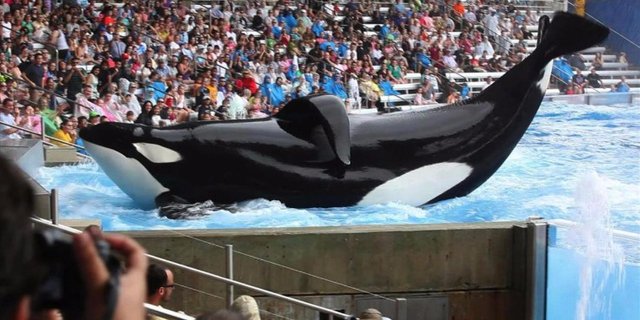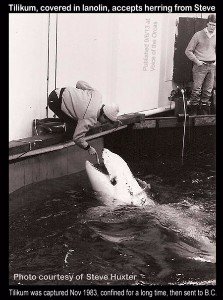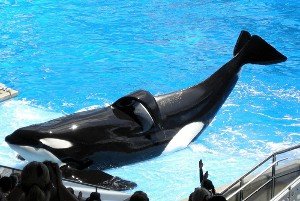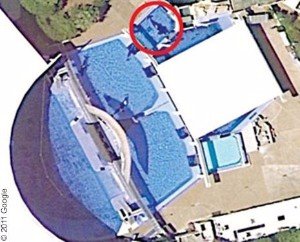Aquarium and Marine parks!!!

Aquariums and marine parks are homes to many aquatic animals, the most common Dolphins and Whales. Dolphins and Whales are both extremely intelligent animals; that like to live in complex, social groups. When they are are placed in captivity they are usually taken away from their families, often after a cruel hunt when they are very young and vulnerable.
A whale or Dolphin can manage to swim 100 miles in just a day: hunting and praying. A concrete tank could never replace its natural home.
Aquariums and marine parks use chlorine and copper sulphate to clean the water and tanks of these animals and has been known to cause Dolphins skin to peel off and may even cause them to become blind. Many marine animals have been known to suffer from peptic ulcers which will often lead to death, due to their unnatural lives in captivity. Due to the mental, emotional, and physical stress that captive whales and dolphins suffer from can weaken their immune system and therefore make them more prone to disease. Even though when they are captivated they have no predators, free of pollution and have other threats taken away from them, they still die young. The death rate from infant whales and dolphins is much higher in captivity.
There are many stories of cruelty at aquariums and marine parks, one of which is about a male killer whale called Tilikum; the largest orca in captivity, weighing 12,500 pounds and measuring over 22 feet in length. Tilikum was caught when he was only 2 years old and teared away from his family, and his ocean home.

This is a picture of Tilikum, covered with lanolin, which is extracted from sheep wool, and applied to the whales skin to prepare them for a long transport without water.
After he was captured, he was kept in a cement holding tank for up to nearly a year at Hafnarfjörður Marine Zoo, Iceland. He was held captive against his will, with all he could do was swim in circles and float aimlessly in the water.
He was then finally transferred to the sealand of the pacific in British Colombia, Canada and forced to call his 100-foot-by-50-feet pool, just 35 feet deep his ‘sad’ new home.
As a training technique they withheld food, and would often suffer from painful attacks by two dominant females, Haida and Nootka, He was forced to perform over many hours, eight times a day, 7 times a week. This constant stress and exhaustion gave him stomach ulcers.
When the park closed its doors at the end of each day, three orcas including Tilikum were crammed into a tiny small-round for more than 14 hours until the park would reopen the next morning.
If tilikum did not perform a trick correctly, food would be withheld from him and his tank mates, which would cause a great deal of tension and as a result of this Haida and Nootka would bite Tilikum all over his body.
On February 21, 1991 sealand trainer Keltie Byrne fell into the pool with these three orcas and was dragged to the bottom by Tilikum and tossed around by all three orca’s. She was the first of three to be killed by Tilikums stress, frustration and confinement.
Shortly after Kelties death sealand closed its doors for good and put Tilikum up for sale.
When the seaworld heard that a 12,000 pound bull, the largest orca on the market was up for sale, they quickly purchased him for their breeding program, giving little though into his reputation for killing and aggression.

Tilikum has a collapsed dorsal fin which is a sign of an unhealthy stressed orca. This never really occurs in the wild.
Over the course of the 21 years at the seaworld, he was confined to a tank containing just 0.0001 percent of the quantity of water that he would travel in just one day in the wild. Tilikum has been involved in a few incidents of aggression. The stress he is under due to being captivated has led to him to show abnormal repetitive behaviour not seen in the wild. This includes chewing on metal gates and the concrete of sides of the tank- so now most of his teeth have been completely worn down to nothing.
The stress Tilikum has suffered form has caused him to become aggressive towards Humans, causing him to take two more lives- those of Daniel P. Dukes in 1999 and Dawn Brancheau in 2010. Tilikum had scalped and dismembered Dawn as well as crushing many of her bones throughout her body before drowning her.
Following Dawns tragic death, Tilikum was kept in a small enclosure that limited his ability to swim, communicate with other orca’s and interact with Humans even further. He was reportedly seen floating endlessly in the water for hours at a time, a behaviour which has never been seen in wild orcas.

In the aerial view of the Seaworld you can see how little room the Orcas have. Inside the red circle is Tilikum, whose nose and tail seem to be bale to touch both sides of the tank at the same time.
After one year in isolation he returned, to performing.
Aggression towards humans is nearly non-existent in the wild but the constant stress of captivity has led to Orcas and other animals in aquariums to become aggressive towards Humans. They also pose a threat to other Orcas they live with.
Facts about aquariums
1.Repetitive harmful behaviour is common, such as the Orca banging his head on a landing platform.
2.The constant stress of confinement causes abnormal behaviour that likely wouldn’t happen in the wild such as vomiting.
3.At Seaworld 37 orcas have died before the age of 30 years old, whereas the average life expectancy in the wild is 30 to 50 years old. No captive orca has come close to the maximum ages of 60 to 70 years for males and more than 100 for females.
4.Stress, boredom, and depression also results from life in a cramped tank